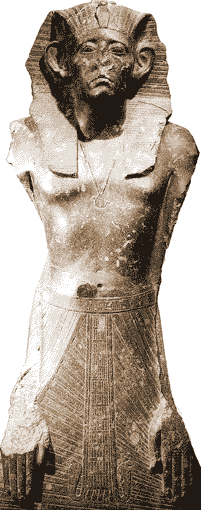 |
The pharaoh
who Manetho described as a 'Great Warrior', and also mentions
that the king was of unusual height - '4 cubits 3 palms and 2
fingers breadth' (over 6ft 6in - 2m).
There
is much evidence to suggest that Sesostris III was more military
active than his 12th Dynasty predecessors, although much of this
activity was against Nubia rather than Egypt's more northerly
neighbours. He was to attack Nubia in several occasions - Year
8, 12 and 15 especially (the Nubians had gradually moved pass
the border of the 3rd Cataract, given impetus by the two previous
kings' lack of military activity). In Year 8, to facilitate the
speed of his fleet attacking the Nubians, he repaired and widened
a canal which bypassed the First Cataract of the Nile (this canal
had originally been built in the Old Kingdom).
On a
stela at Semna, Sesostris III describes how he terrified the
Nubians:
"I captured
their women, I carried off their subjects, went to their
wells, killed their bulls: Cut down their grain and set fire to it".
You can read the full text HERE
By Year
19 the Egyptians were able to sail up the Nile as far as the
2nd Cataract, and to safeguard Egypt's power in the area Sesostris
III built eight mud brick fortresses between Semna and Buhen:
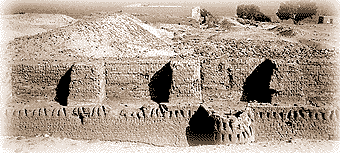
|
|
Not only did Sesostris III have to deal
with his southern neighbours when he became king - the old threat
to the stability and power of the Pharaoh in the Middle Kingdom
once more reared its head .... the power of the Nomarchs.
Earlier
rulers in the 12th Dynasty had needed the help of the nomarchs
and so they had been granted and kept special privileges and
ancient rights - things which were later to prove a constant
threat to pharaonic power. It is not known how, but Sesostris
III finally brought an end to the nomarch / nobility - a new
administration took full control over the internal government
(Sesostris III divided the country into 3 administrative departments
- North, South and Head of the South (Nubia) all of which reported
to the King's deputy - Vizier), brought an end to great regional
tombs of the nomarchs - a major threat had finally gone.
Sesostris
III the builder:
Money
gained from his Nubian campaigns was re-directed into building
works - statues of Sesostris III were placed at the temple of
Mentuhotep II at Deir el-Bahri. A temple was built to Mont, a
god of war at Medamud near Karnak.
|
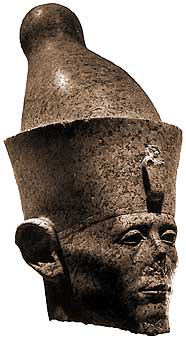 |
The
Pyramid of Sesostris III
Original
Height - 78.5 m
Length
of Side - 105m
|
 |
The most northerly of the
pyramids at Dahsur, built of unfired brick which was originally
covered with great slabs of limestone. Over the course of the
centuries this limestone has been robbed away to leave a pile
bricks 30m high. The trench / dip in the centre was caused by
the explorers R. W. H. Vyse and J. S. Perring in 1839 to enable
them to find the burial chamber.
Following the practice
of his father, Sesostris II, to deter robbers in entering the
pyramid, the entrance to the burial chambers of the pyramid was
placed outside on the western side. However all that remains
of Sesostris III's burial is an empty granite sarcophagus.
But in 1894 Jacques De
Morgan found another shaft ('E' on the plan below) which led
to a burial complex of four tombs of Queens and Princesses. He
also found six wooden boats in two masatabas on the southern
side of the pyramid ('G') - in 1994 a further expedition by the
New York Metropolitan Museum of Art found jewels belonging to
Queen Khnemet-nefer-heget - mother of Sesostris III.
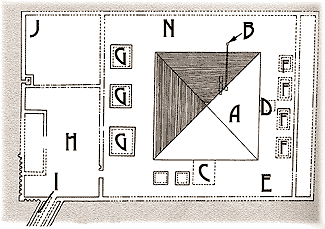
| A - Pyramid |
F - Mastabas
of Princesses |
| B - Entrance |
G - Southern
Mastabas |
| C - Remains
of an east chapel |
H - Courtyard |
| D - Remains
of a north chapel |
I - Ramp |
| E - Shaft |
J - Boat
Crypt |
|
|
Inner Chambers
of the Pyramid

| A
- Corridor |
E
- Antechamber |
| B
- First Room |
F
- Burial Chamber |
| C
- Second Room |
G
- Sarcophagus |
| D
- Vestibule |
|
|
�
The Abydos
tomb of Sesostris III:
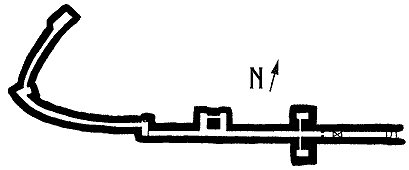
Although he was buried
in his Dashur pyramid, he also possessed a rock-cut tomb which
was located at Abydos.This rock cut was purely symbolic, even
so it contained a granite sarcophagus, canopic jars in the burial
chamber and for protection : plug blocks and dummy passages (the
tomb had been robbed in antiquity). The tomb is entered from
within a T-shaped enclosure above ground - a mortuary temple
was located 200m away
|



